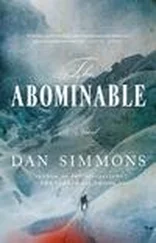After Irving reported to him way back in early February about the young lieutenant’s difficulties in following Lady Silence or communicating with her about where and how she got the seal meat and fish Irving swore he had seen her with, Crozier contemplated threatening the girl’s life with pistol or boat knife to make her show them how she found the fresh food. But in his heart he’d known how such a threat would end up – the Esquimaux wench’s tongueless mouth would stay firmly shut and her huge dark eyes would stare unblinkingly at Crozier and his men until he had to back down or make good on his threat. Nothing would be accomplished.
So he’d left her out in her little snow-house Irving had described to him and allowed Mr. Diggle to give her the occasional biscuit or scrap. The captain had tried to put her out of his mind. That he had been shocked to be reminded she was still alive when the lookout reported her following a few hundred yards behind Hodgson’s and Irving’s relay trip to Terror Camp last week showed Crozier that he had succeeded in not thinking about the wench. But he knew he still dreamed about her.
If Crozier were not so very, very tired, he might have taken some small pride in the design and durability of the various sledges that the men were now man-hauling southeast across the ice.
In mid-March, even before it was certain that Erebus would break up from the rising pressure, he had Mr. Honey, the expedition’s surviving carpenter, and his mates, Wilson and Watson, working day and night to design and build sledges that could haul the ships’ boats as well as gear.
As soon as the first prototype larger oak-and-brass sledges were finished that spring, Crozier had the men out on the ice testing them and learning the best ways to haul them. He had the riggers and quartermasters and even the foretopmen constantly fiddling with the design of the harnesses to give the men the best pulling leverage with the least interruption of their movement and breathing. By mid-March, the sledge designs were set, more were being built, and it seemed that a design of harnesses for eleven men for the large sledges carrying boats and seven men for the smaller supply sledges would be best.
This was for the initial supply crossings to Terror Camp on King William Land. If they took to the ice after that, Crozier knew, with some of the men too sick to pull and perhaps others dead by then, eighteen boats and sledges, each loaded to the gunwales with survival rations and gear, requiring man-hauling by one hundred men – or fewer – it would mean fewer than eleven men pulling each burden. More work and even heavier loads for men who presumably would be deeper in the pit of scurvy and exhaustion by then.
By the last week in March, even as Erebus was in her death throes, both crews were out on the ice in darkness and the brief sunlight, competing in man-hauling contests with the different sledges, finding the right match of men to sledge, learning the right techniques, and putting together the best teams composed of men from both ships and all ranks. They were competing for cash – silver and gold – and even though Sir John had planned to buy many souvenirs in Alaska, Russia, the Orient, and the Sandwich Islands and there were chests of shillings and guineas in the dead man’s private storeroom, these coins came out of Francis Crozier’s pocket.
Crozier wanted badly to head toward Baffin Bay as soon as the days grew long enough to support long-distance sledging. He knew instinctively and from listening to Sir John’s tales and from reading George Back’s history of ascending more than 650 miles of the Back’s Great Fish River to Great Slave Lake fourteen years ago – the volume was in Terror ’s library and now in Crozier’s personal pack on one of the sledges – that the odds of any of them finishing or surviving the trip were low.
The 160-some miles between Terror ’s position off King William Land and the mouth of Great Fish River might not be traversable, even as a prelude to the arduous voyage up the river. It combined the worst of coastal ice with threats of open leads that could make them abandon the sledges and – even if there were no leads – the assured agony of hauling sledges and boats across the frozen gravel of the island itself, all while exposed to the worst of the pack-ice storms.
Once on the river, if they ever reached the river, they would be confronted with what Back had described as “a violent and tortuous course of 530 geographical miles, running through an iron-ribbed country without a single tree on the whole of its banks” and then “no fewer than 83 falls, cascades, and rapids.” Crozier had trouble imagining his men, after another month or more of man-hauling, being fit enough or well enough to confront 83 falls, cascades, and rapids in even the sturdiest boats. The portages alone would kill them.
A week earlier, before heading out with the boat-sledge teams to Terror Camp, Surgeon Goodsir told Crozier that the lemon-juice antiscorbutic, their only defense against scurvy now – as weak as it had become – would run out in three weeks or less, depending upon how many men died between now and then.
Crozier knew how quickly the full onslaught of scurvy would weaken all of them. For this 25 miles to King William Land with light sledges and full teams, on full half rations for the crossing, on a runners path that had been beaten into the ice for more than a month, they had to cover a little more than eight miles a day. On the rough terrain or coastal ice of King William Land and south, that distance might be cut in half or worse. Once the scurvy began having its way with them, they might only cover a mile a day and, if the wind died, might well not be able to pole or paddle the heavy boats upstream against the current of Back’s River. A portage of any distance in the weeks or months to come might soon become impossible.
The only things working in their favor in heading south were the very long-shot chance that a rescue party was already heading north from Great Slave Lake, searching for them, and the simple fact that it would be getting warmer as they traveled farther south. They would be following the thaw, at the very least.
Still, Crozier would have preferred staying in the northern latitudes and going the longer distance east and north to Boothia Peninsula and then across it. He knew there was only one even relatively safe way to attempt that: take the men to King William Land, cross it, then make the relatively short traverse across open ice, sheltered from the worst of the northwest wind and weather by the island itself, to the southwestern coast of the Boothia, then slowly north along the edge of the ice or on the coastal plain itself, and finally across the mountains toward Fury Bay, hoping every step of the way to meet Esquimaux.
It was the safe way. But it was the long way. 1,200 miles, almost half again longer than the alternate route south around King William Land and then further south up Back’s River.
Unless they met friendly Esquimaux soon after crossing to the Boothia, they would all be dead weeks or months before such a twelve-hundred-mile trip could be completed.
Even so, Francis Crozier would have preferred to have wagered everything on a dash straight across the ice – northeast over the worst of the pack ice in a mad attempt to replicate the astounding 600-mile small-group sledge trip made by his friend James Clark Ross eighteen years earlier when the Fury was frozen in on the opposite side of the Boothia Peninsula. The old steward – Bridgens – had been absolutely correct. John Ross had taken the best bet on survival, forcing his way north by foot and sledge and then in boats left behind up to Lancaster Sound and waiting for whalers. And his nephew James Ross showed that it was possible – just possible – to sledge from King William Land back to Fury Beach.
Читать дальше












